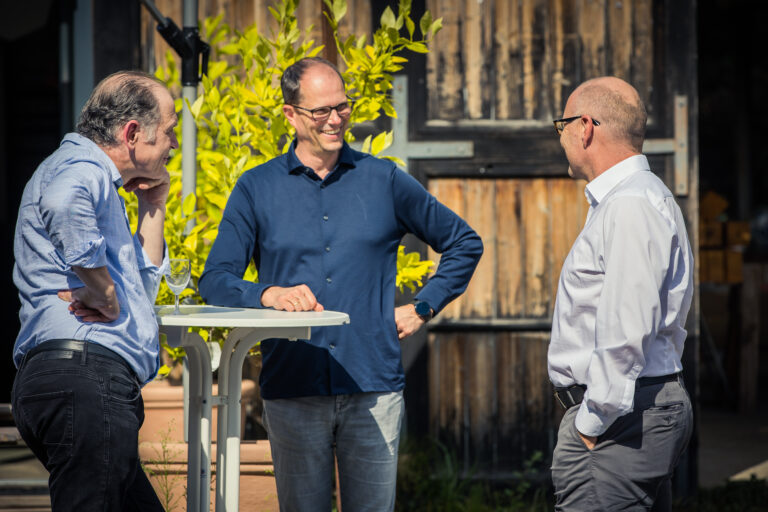In the “exChange” project from transactional to transformational leadership culture
In our fast-moving times, decisions need to be well well thought out, the customer’s requirements implemented promptly, and challenges be solved in a meaningful way. This can only be represented by organizations in which thinking and active employees are active: Employees who support decisions employees who support decisions, recognize requirements and play their part in the company’s success.
For this reason, we encourage managers to involve their employees in the focus of attention. They should be the apple of the company’s eye be The Stuttgart Stock Exchange has taken on this task with our support. adopted.
An employee survey as the starting signal for a new leadership culture
The Great Place to Work survey from 2017 got the ball rolling: the results of the survey revealed that employees at Börse Stuttgart are only partially satisfied with the leadership culture at their company. It became clear that employees would like to see more transparency and appreciation in order to be able to build greater trust. The participants in the study also called for a clearer set of goals and guiding principles, which supervisors should also follow with their behavior as role models.
How did the Stuttgart Stock Exchange deal with these findings? The most pressing issues were identified from the survey results.
These were discussed in cross-hierarchical working groups, and the employees were the driving force behind this. The two working groups on the
topic of “trust in the manager” came to the conclusion that supervisors should go through some kind of assessment to get a location check.
In parallel, the stock exchange’s management board, which had been reconstituted in the meantime, had worked out a modified strategy for 2022 with an even clearer focus on investors and their needs. It quickly became clear that a number of prerequisites are important for this customer orientation:
- wead more Digitization projects
- A future organizational structure that is more customer and competition oriented
- a new mindset among employees and managers
The strategy was thus not only focused on technology, processes and structures, but thought holistically. New digitization projects including start-up initiatives were quickly designed. But how could culture, values and changed leadership models be integrated into Strategy 2022?
After the first joint discussions between the Stuttgart Stock Exchange and us, it became clear to everyone that the strategic realignment of the stock exchange and the results of the working groups made it sensible to take stock of the leadership situation at the stock exchange. At this point, the Stuttgart Stock Exchange asked us to focus on and examine three factors and examine them: leadership potential, competencies for the new requirements and the new requirements and the mindset(motivations and values).
The transformation path should be defined with the individual development potentials of the managers. We are deliberately talking here about a “path” and not a “goal”. Because a healthy leadership culture is not a rigid target image, but is constantly evolving, is in motion and is
adapts to the conditions and requirements. But how can such a location determination be successful without the executives are put on the defensive too much and it feels, as if chaff is being separated from the wheat? We have led the way here with our Leadership Potential Compass (LPK) chosen, which promotes a high level of self-knowledge.
The Leadership Potential Compass: A Package of Methods to Determine Your Current Position
In order to get a holistic picture of the prevailing management culture, the entire management team of the Stuttgart Stock Exchange went on a site assessment. We supported the process with our Leadership Potential Compass. This combines individual potential interviews with a leadership simulation and a psychometric procedure, the Leadership Potential Cockpit. In this way, the potential, attitudes, values and behavior of managers can be systematically identified. If you would like to know more about the individual building blocks of the process, feel free to take a look here.
With the help of the Leadership Potential Compass, important questions were answered as part of the transformation process:
- Which potential factors that have a high influence on leadership success do the managers possess?
- What competencies does the exchange want and are they congruent with the leaders’ strengths?
- What motivations and values that have a positive impact on leadership culture as embedded in leaders drive leaders?
The specific competencies and values of the Stuttgart Stock Exchange were integrated into this and considered important for a new trusting cooperation between managers and employees. After assessing the situation through our Leadership Potential Compass Each manager received feedback on his or her own performance in an interview. potential factors, competencies, and values and motivations. The main objective was to identify strengths, areas for development and targeted measures for the to show executives. From the overall picture of the merged results a potential portfolio was created. Fortunately, the Studies show a good robustness of the managers, a positive inner Attitude and growth orientation. The main areas of development were in the strongly prevailing transactional leadership culture as well as in the mobilization, inspiration and promotion of employees (empowerment).
It was thus clear that the management culture must develop more in the direction of “New Work”. Leading with purpose and inspiration; creating freedom and letting go; establishing cultural rules; focusing on the right people – all of this should be encouraged. This paved the way for the actual transformation process at the Stuttgart Stock Exchange, which was christened exChange .
From transactional leadership to transformational leadership
The goal of exChange was to strengthen managers in their ability to convincingly fulfill their role model function and thereby acquire trust, respect, appreciation and loyalty. Employees are intrinsically motivated and inspired to change (transform) their behavior and their willingness to learn and perform.
The transformational leadership model of Prof. Dr. Waldemar Pelz was used, which was slightly adapted to the needs of the Stuttgart Stock Exchange, e.g. by integrating the company-specific values.

This model was declared the guiding star for the new leadership culture and thus for the exChange process in the kick-off day with all managers.
The exChange concept: discovering what transformational leadership is all about
For the further procedure, an exChange process with different activation modules was developed in coordination with the management and the project team of the Stuttgart Stock Exchange in order to make the new type of leadership discussable, experienceable and reflectable in very different ways. At intervals of one to two months, the executives of Börse Stuttgart work in so-called pit stops on topics that promote the further development of their leadership culture towards transformational leadership.
The input received and the new findings are then to be tested in everyday work. To support this process, reviews are held between pit stops to enable and shape implementation. Here, the participants set the topics and bring in their practical experiences, which are reflected on together. In parallel, managers are supported with coaching on their individual development topics as needed.
A mentoring system promotes the exchange of managers across divisions and hierarchies in the pit stops. The goal is to stay in conversation with each other, exchange best practices, share visions and ideas, and promote the flow of information within the company.
Goals of the pit stops in the transformation process:
- Stop and reflect
- Fill methods
- Receive metered impulses
- Develop solutions
- Promote exchange of experience
- Continue: Apply and implement what has been learned
Insight into the fourth pit stop: communication
In addition, pit stops are occasions where participants bring their own issues and receive advice in a collegial consultation. For example, it was possible to work out solutions for an agreement that had not taken place but was necessary, thereby breaking up the rigidity in a project. Because the solution always lies in the system – and no one knows it better than colleagues.
Organic quality management (OQM) for measuring progress in the transformation process
The so-called OQM® method (organic quality management) was used to measure status and progress in the exChange process. An internal survey enabled all the company’s employees to be involved in the transformation process as co-creators. With the results of the survey, the teams worked on concrete measures for improved teamwork and further development of the entire company in workshops.
The survey showed that teamwork and customer orientation are rated as very positive. On the subject of vision and values, employees wanted to be more intensively involved. This in turn gave rise to small interactive formats in which employees can discuss the company’s visions and values directly with management.
The OQM survey was planned as a recurring element so that the effectiveness of the measures could be checked. With this analysis, exChange can always be aligned with the needs of the workforce. An exchange platform on exChange enables employees to stay up to date, think along and help shape the process. Through the communication channel, all stakeholders can share weekly updates from the process, send invitations to workshops, or post video messages.
Feedback from employees and managers on the transformation process
The participants in the exChange process of the Stuttgart Stock Exchange are very positive about the measures from the beginning. There was little resistance at the beginning, predominantly openness to change. The exChange concept is currently approaching the halfway point, and the transformation process remains in motion.
An initial conclusion is that the holistic approach comprising vision, business strategy, organizational and HR development, and leadership culture has more than proven its worth and has been very well received. It is exemplary that the top management including the chairman of the supervisory board of the Stuttgart stock exchange participate in the exChange building blocks as participants just like all other executives. Right in the middle instead of just being there. This is exactly what transformational leadership is all about.
In the regular pit stops, managers can pause, refuel with input, exchange ideas with colleagues and shape the transformation with new impulses.
One participant recounts, “While it is challenging to take time out of a busy workday for the exChange measures, it is a real benefit in terms of new impulses, time for reflection, exchange with colleagues and practice-relevant exercises. The continuous process with stops in between allows us to change attitudes and behaviors for real implementation in everyday work.”
As with any change process, some measures achieve rapid effects, while other issues require a change in mindset or (un)conscious self-image – and this does not happen overnight. Characterized by classical hierarchical thinking, the following challenge in particular became apparent, namely the tendency to point at the respective other actors in the process:
- Upstairs is thinking, doing, and investing, and slowly asking, “When are YOU downstairs going to take advantage of the new design opportunities and get going?!”
- Downstairs the employee reacts more classically with: “Do YOUR homework first! You first show me what you are talking about!
- The middle, middle management and operational managers are now in the classic sandwich position: demanded and held accountable from above, not supported from below, but eyed and skeptically observed along the lines of, “Get on with it…”
In terms of their attitude, some managers react from the pattern from above, others from below . With this kind of “fingerpointing,” there is a danger that the levels of the company will slowly lose or devalue each other. This can lead to an increasingly energetic and paralyzing state that jeopardizes or prevents successful developments in individual parts of the company, teams or employees.
Outlook for the further transformation process
In the second half of exChange, we therefore want to devote even more attention to the topic of self-responsibility – independent of hierarchy:
- What can I myself make possible in my sphere of influence (Empowering)?
- Where can I myself encourage others (Encouraging)?
- How can I enable employees in my sphere of influence? (Enabling)?
Whoever asks these questions is no longer a superior, but a “leader“. Keeping employees in mind is a rewarding journey that creates bonding, enables humanity, and ultimately makes job performance more stable and reliable. In the second half of exChange, we want to sensitize the managers of the Stuttgart Stock Exchange to their employees by cultivating these questions.
This is intended to encourage managers to try out unfamiliar leadership patterns and to develop an individual, open and adequate culture of discussion and work. Our goal is the inner attitude “I am the master of the process!” and the activation of the question: “What can I contribute to the company’s success?”
What we were able to learn through the transformation process
In general, companies and their employees are currently in a transition phase. Generation Y and Z in particular are less and less concerned with just work and pay, but rather with recognition, respect, identification with the company and a recognizable sense of purpose in the job (the question of “why”). The focus is also more on togetherness than it was a few years ago. These aspects are increasingly becoming identifiers of satisfaction, morale or job choice.
On the other hand, most employees and managers are still strongly hierarchical and have demands on leadership: “Organize to make me feel good” or “Sort it out for me so I feel better.” These thought patterns ignore one’s own sphere of responsibility and influence. More constructive would be this attitude toward the manager: “Create more opportunities for me to get involved, to help shape my workday in a meaningful and purposeful way.”
This transition phase is currently occurring in many companies. This gives concrete leadership and middle management a new, exciting and future-oriented main task: to develop a new way of contact between employees and managers. For this, it is important to recognize the leadership of employees as a permanent and continuous process in order to motivate more and more people to take responsibility for themselves and to shape their own lives (within their means). This is done not only through the implementation of measures, but also through courageous, creative, individual designs in our own teams. Often it is small actions, interactions or activities that not only strengthen team building, but also the contact between manager and employees.
A long breath is needed here. These changes take time and patience from those involved. To keep at it, it helps to acknowledge and appreciate the changes that have already occurred. One thing is clear: this process is worthwhile.
Contact us
Do you also want to change your leadership culture sustainably and take the next step towards Next Leadership or People Company? Feel free to contact us. Also feel free to take a look at our solutions.










